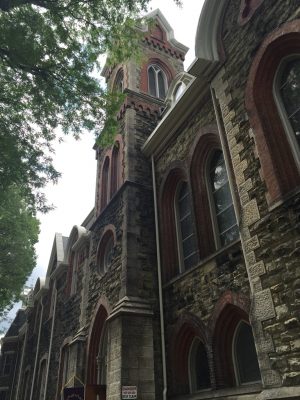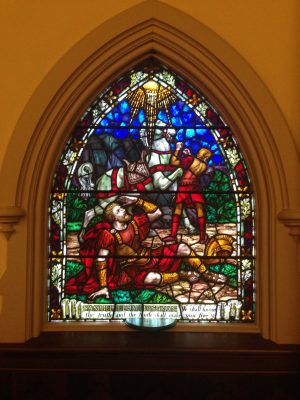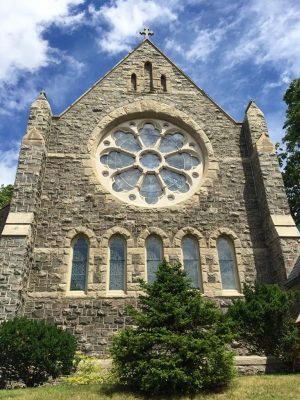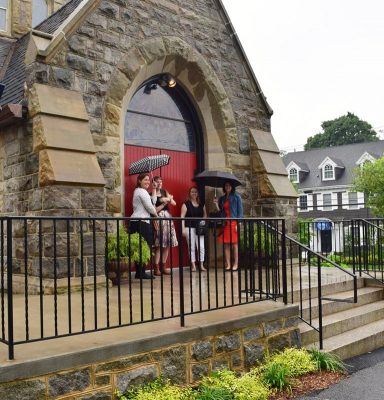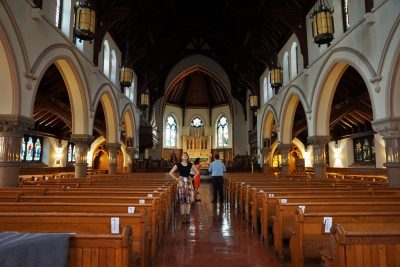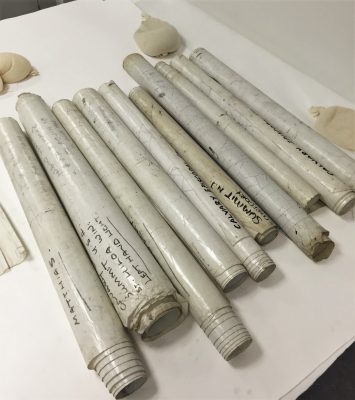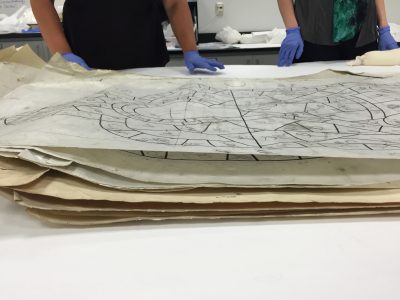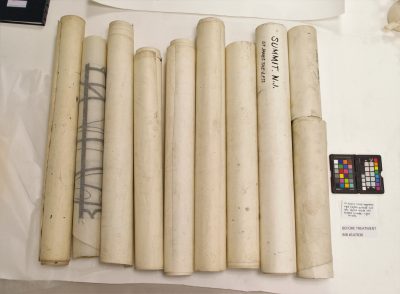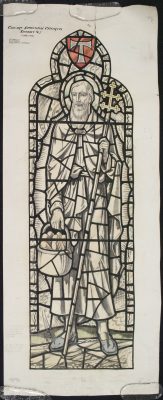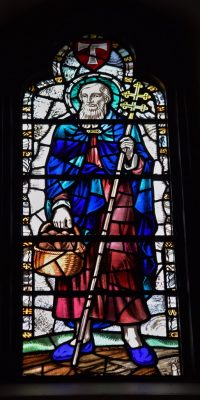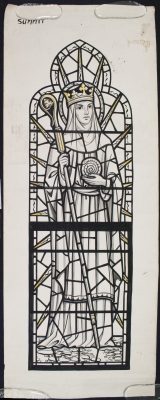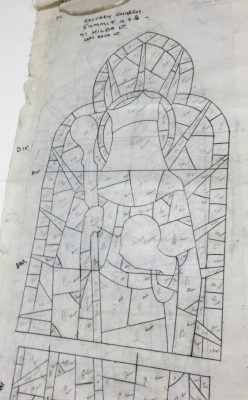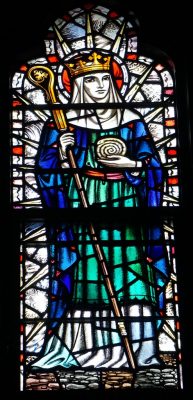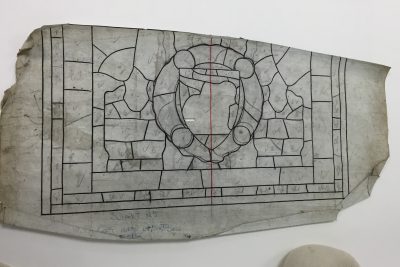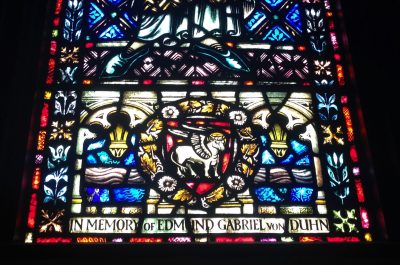This post comes from Laura Hashimoto and Bonnie Hodul, Rakow Library interns working on the conservation of the Whitefriars stained glass cartoon collection over the summer, in conjunction with West Lake Conservators. Read more about this project and the collection in previous posts.
Although we have spent most of the summer conserving cartoons in the Rakow Research Library’s preservation lab, we’ve also had the chance to go see some Whitefriars stained glass in person. One of the project’s major focuses is to reach out and form connections with the public (through social media and blog posts such as this), as well as with institutions that have stained glass windows made by the Whitefriars company. We have selected rolls this summer with the goal of reaching local and international sites. The project allows us an opportunity to form multidisciplinary connections, and create an educational dialogue about the process of stained glass window making.
- Exterior of Park Church, Elmira, NY.
- Whitefriars stained glass window in Park Church, Elmira, NY.
We have been lucky enough to see several of the stained glass window installations made from cartoons we unrolled and stabilized here in the lab. Earlier this summer, we visited Elmira, New York, which is home to both Park Church and Trinity Episcopal Church. The Whitefriars cartoons for Park Church were treated by paper conservator Moya Dumville at West Lake Conservators at the very beginning of the project. The Whitefriars cartoons for Trinity Church have not yet been found amongst the many unidentified rolls in the collection. It was a wonderful opportunity to be able to visit both churches and see their installations!
At the end of July, we traveled to New York City and New Jersey to visit two churches and one synagogue that have Whitefriars stained glass windows. We were accompanied by Rakow librarians Jim Galbraith and Rebecca Hopman, as well as Kim Thompson from the Museum’s communications department. Not only was it a blast to take this trip with them, but the institutions we visited were truly astounding.
- Exterior of Calvary Church, Summit, NJ.
- The group finds shelter from the rain before exploring the interior of Calvary Church.
First thing in the morning, we headed to Calvary Episcopal Church in Summit, New Jersey. Laura had visited this church previously, and let us in on the magic that lay in store for us … the church is almost completely filled with Whitefriars stained glass windows! Before our visit, we searched the archives and found a roll containing 20 individual objects that related to the stained glass windows in this church. It was mislabeled as “Cazbury” Church, but the location of Summit, NJ, tipped us off that this roll might be a match for Calvary Church.
- Bonnie gazes up at the spectacular interior of Calvary Church, Summit, NJ.
- Laura and Jim study the windows closely to find matches to the Whitefriars cartoons in the Rakow Research Library.
The roll held eight paper cartoons, which rendered detailed images of various saints for the clerestory, and 11 waxed linen canvases that showed the cut-lines for the individual glass pieces and leadwork that would hold the window together. There was also a partial tracing paper matching one of the saints.
- Individual rolled canvas cartoons from Calvary Church in Summit, NJ.
- Objects in this roll for Calvary Church were all stacked first, and then rolled together.
- Individual rolled paper cartoons from Calvary Church in Summit, NJ.
The cartoons represented a total of 12 saints. Some of the paper cartoons matched the canvases, but others had no match. We were able to identify many of the saints through photos of the windows on the church’s website, by cross-referencing this information with labels on the canvases, and by researching symbolism evident in the drawings.
- Paper cartoon for St. Philip in the Rakow Research Library Whitefriars collection. We do not have a canvas cartoon for this design. CMGL 147836
- Stained glass window depicting St. Philip in Calvary Church, Summit, NJ, dedicated to a member of the parish in early 1970s.
- Paper cartoon for St. Hilda in the Rakow Research Library Whitefriars collection. CMGL 163974
- Part of canvas cartoon for St. Hilda in the Rakow Reasearch Library Whitefriars collection. CMGL 163982
- Stained glass window depicting St. Hilda in Calvary Church, Summit, NJ.
At the church, we realized there were many more saints in the clerestory than what we have in this roll of cartoons. We suspect there is another roll in the archives that is unlabeled, holding the other Whitefriars designs. However, we also discovered that the 12 objects we have belonged together; in the church, the saints hung in pairs. Our 12 saints were all paired together!

Paired saints: (left) St. Matthias and (right) St. Simon. We have both canvas and paper cartoons for St. Matthias, and a canvas cartoon only for St. Simon.
One of the canvases in the roll was partial, and the design was dissimilar to the others. At the church, we were able to match it with a different Whitefriars window, the bottom of which had been restored. The partial canvas we found was a match!
- Partial canvas cartoon for restoration of St. Luke stained glass window in Calvary Church, Summit, NJ. CMGL 163987
- Detail of restored area of St. Luke stained glass window in Calvary Church, Summit, NJ.
- Full window of St. Luke in Calvary Church, Summit, NJ. Bottom was restored.
Up next: Connecting Paper and Glass, Part 2, where we see Whitefriars stained glass in the heart of New York City.
Follow the progress of the 2016 project.
The Rakow Research Library is open to the public 9am to 5pm every day. We encourage everyone to explore our collections in person or online. If you have questions or need help with your research, please use our Ask a Glass Question service.

